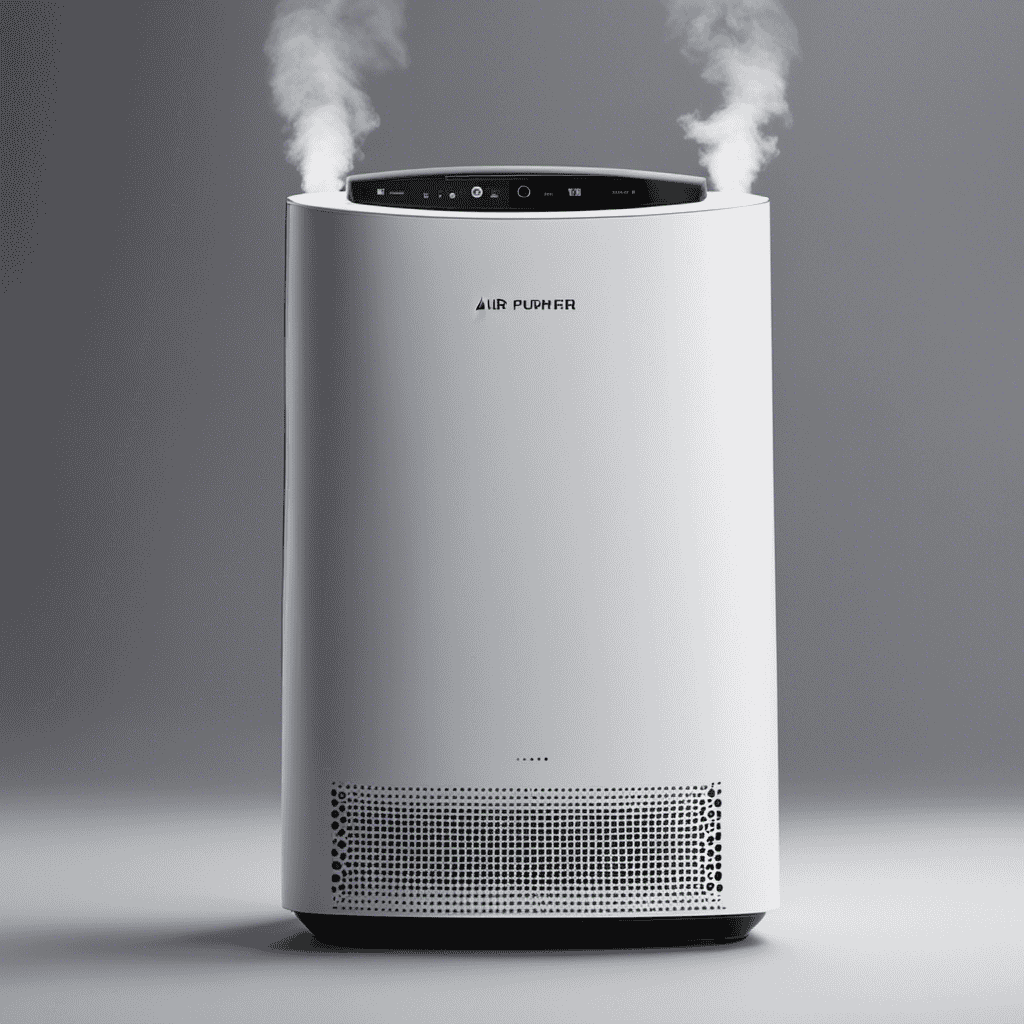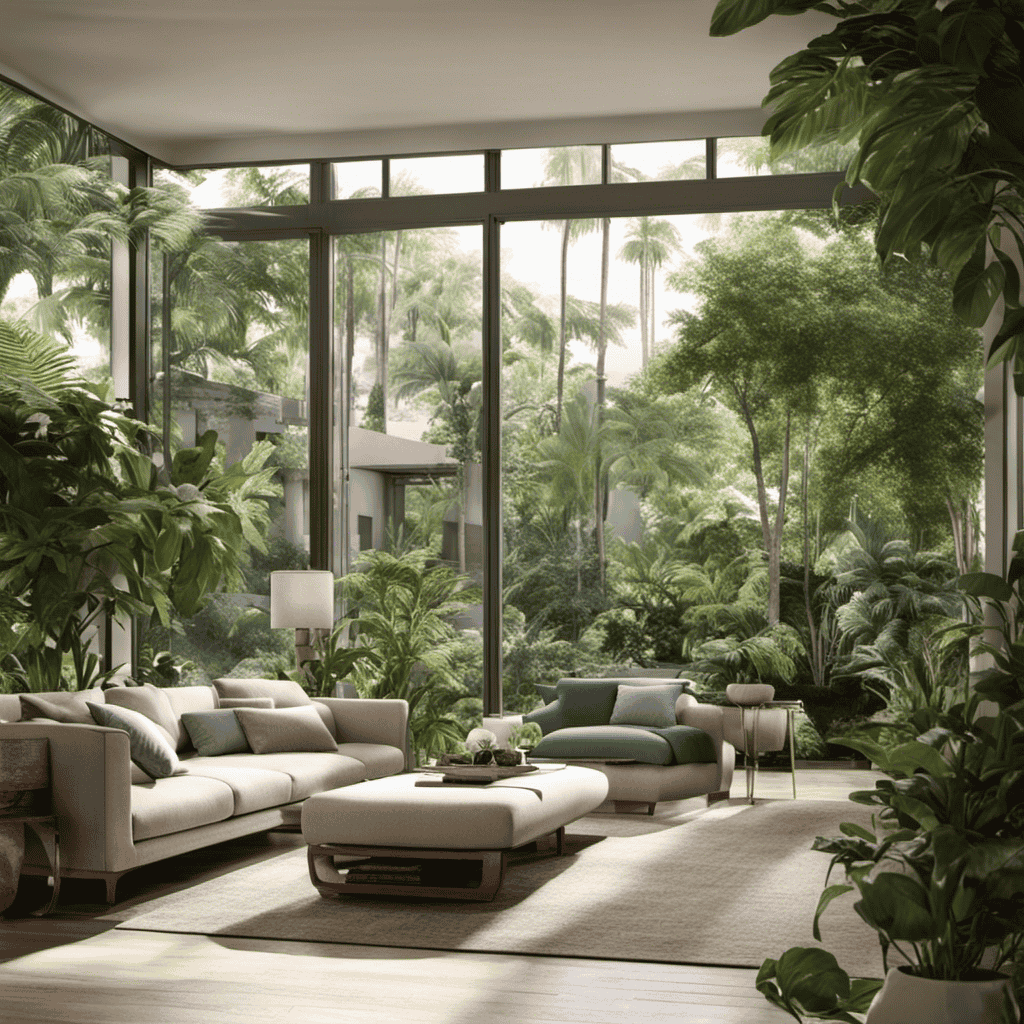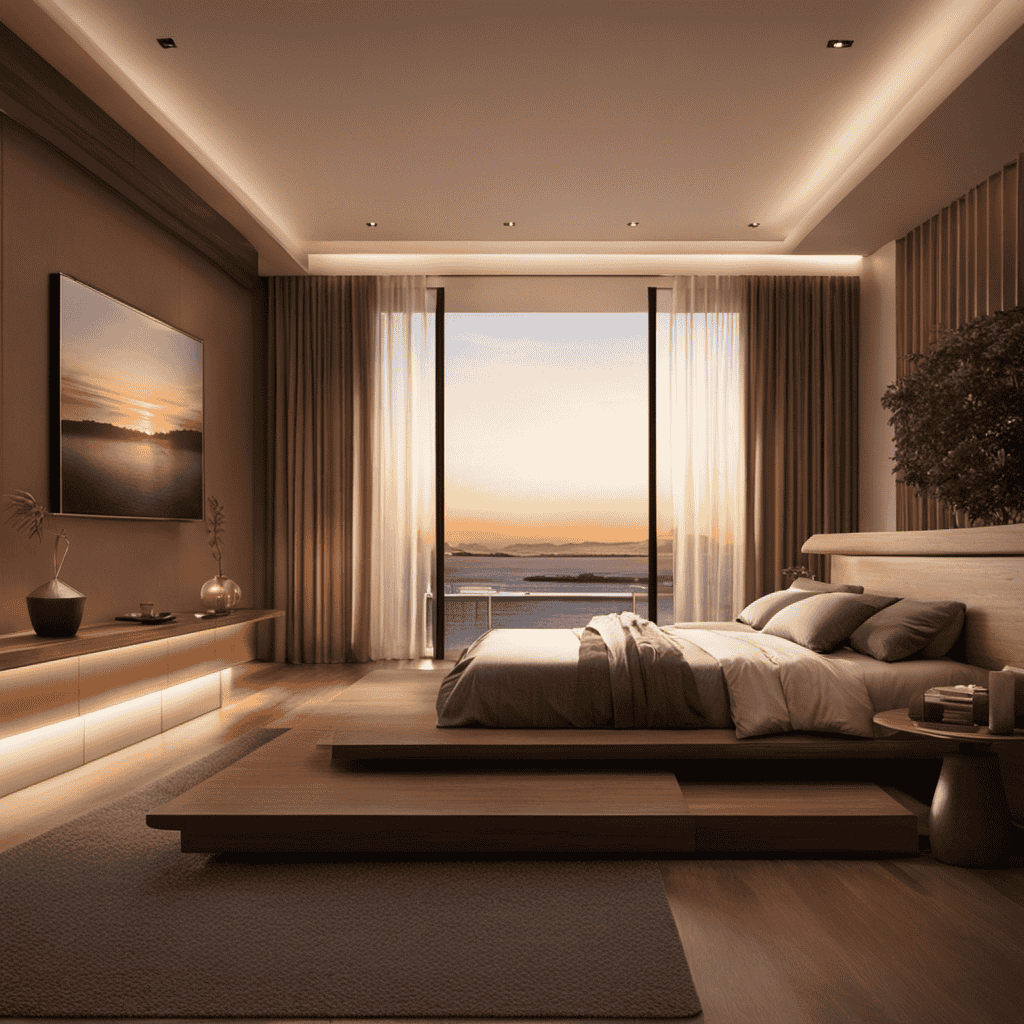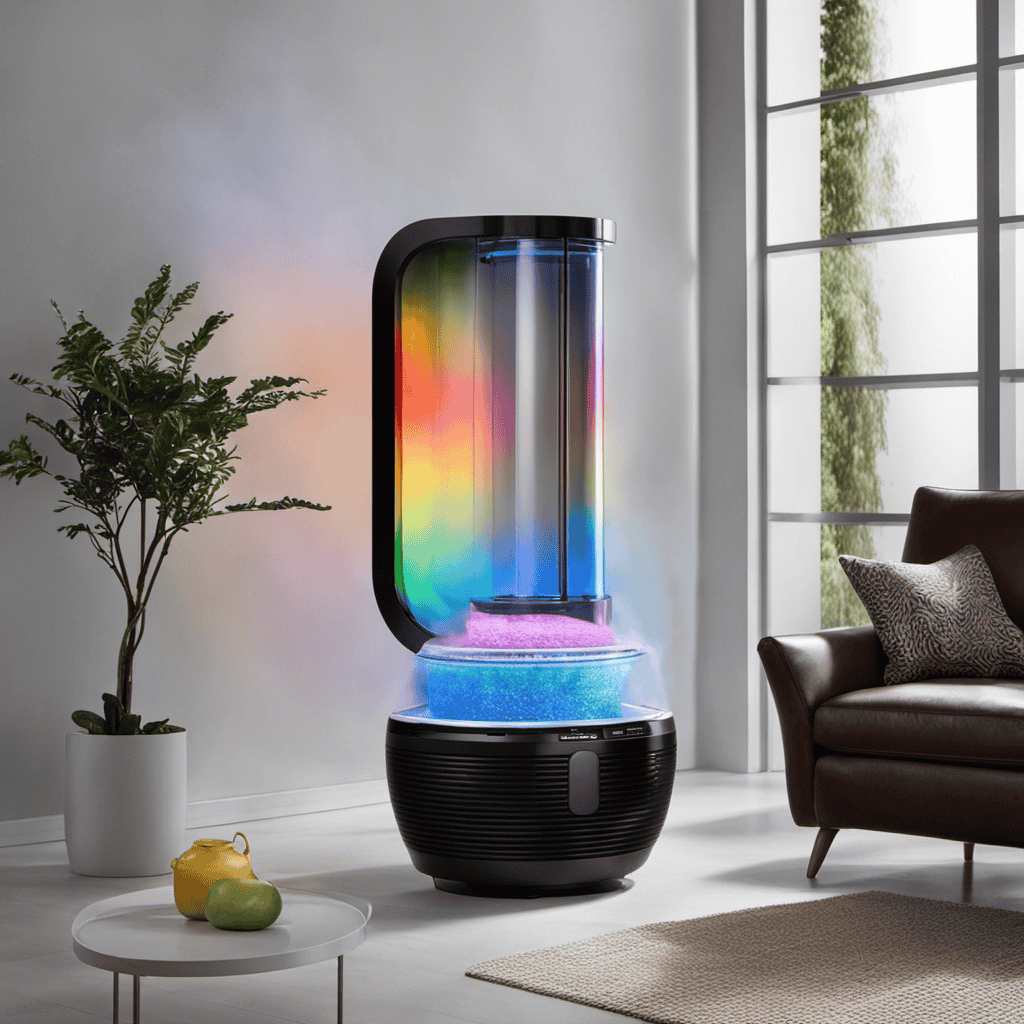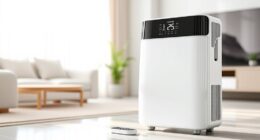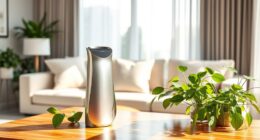I have a little secret to share with you: when it comes to air purifiers, it is vital to know which side the smoke goes in. [Translated in English (United States)]
As someone who’s battled with smoke-filled rooms, I understand the frustration of not having clean air to breathe. That’s why I’ve done my research to uncover the mysteries of smoke filtration.
In this article, I’ll guide you through the functionality of air purifiers, the proper placement, and how they capture those pesky smoke particles.
Get ready to breathe easy again.
Key Takeaways
- Air purifiers filter and remove airborne pollutants like smoke, dust, pet dander, and pollen from indoor air.
- Proper placement is crucial for the effectiveness of an air purifier in removing smoke.
- Optimal smoke filtration ensures the removal of harmful particles and odors from the air.
- Air purifiers draw in air through a fan and pass it through filters designed to capture and trap smoke particles.
Understanding the Air Purifier’s Functionality
The smoke goes into the air purifier through the intake side.
Understanding air purification technology is essential in realizing the benefits of using an air purifier. Air purifiers work by filtering and removing airborne pollutants, such as smoke, dust, pet dander, and pollen, from the indoor air.
The intake side of the air purifier is designed to draw in the surrounding air, carrying the smoke particles along with it. Once inside, the air passes through a series of filters, such as a pre-filter, HEPA filter, and activated carbon filter, which trap and eliminate the pollutants.
The Importance of Proper Placement
Proper placement is crucial when it comes to ensuring the effectiveness of an air purifier in removing smoke. To maximize effectiveness and maintain the purifier’s performance, it is important to consider the following:
- Distance: Place the air purifier near the source of smoke to capture it more efficiently.
- Orientation: Position the air purifier in a way that allows the smoke to directly enter the intake vents.
- Airflow: Ensure that the purifier has sufficient space around it to allow proper airflow and circulation.
By following these guidelines, you can enhance the air purifier’s ability to remove smoke effectively.
However, proper placement is only one of the key factors to consider when positioning the air purifier. Let’s explore other important considerations that can further optimize its performance.
Key Factors to Consider When Positioning the Air Purifier
When it comes to choosing an air purifier for smoke filtration, there are three key factors to consider: optimal smoke filtration, airflow, and purification efficiency.
Optimal smoke filtration ensures that harmful particles and odors are effectively removed from the air, providing a clean and healthy environment.
Airflow plays a crucial role in distributing the purified air evenly throughout the room, while purification efficiency determines how well the air purifier can remove smoke particles of different sizes.
Optimal Smoke Filtration
For optimal smoke filtration, it’s important to ensure that the air purifier is properly positioned. By positioning the air purifier correctly, you can maximize its efficiency in capturing and removing smoke particles from the air.
Here are three key factors to consider:
-
Placement: Position the air purifier in the area where smoke concentration is highest, such as near a smoking area or close to the source of smoke.
-
Direction: Make sure the air purifier is facing the smoke source to capture the particles more effectively.
-
Height: Place the air purifier at a higher level, as smoke tends to rise. This allows the purifier to capture smoke particles before they disperse further.
Airflow and Purification Efficiency?
The placement and direction of the air purifier greatly affect its efficiency in capturing and removing smoke particles from the air. When positioning the purifier, it is crucial to consider the airflow direction.
Placing the unit in an area where the smoke is likely to pass through ensures that the purifier can effectively capture the smoke particles.
The direction of the airflow within the purifier is also important. It is designed to draw the air in and trap the smoke particles through its filtration system.
By understanding the airflow direction and ensuring proper placement, the air purifier can maximize its smoke particle capture capabilities.
Now, let’s explore how smoke travels in the air and why it is important to have an efficient air purifier.
How Smoke Travels in the Air
To understand how smoke travels in the air, imagine yourself standing near the air purifier and noticing which side the smoke enters. Smoke is a common source of air pollution, and understanding its movement is crucial for maintaining respiratory health. Here are some key points to consider:
- Smoke particles are tiny and can easily become airborne, contributing to air pollution.
- When smoke enters the air purifier, it is filtered through various mechanisms such as electrostatic precipitation or activated carbon.
- The direction of smoke entry can help determine the efficiency of the air purifier in removing harmful particles.
How Air Purifiers Capture Smoke Particles
Understanding how air purifiers capture smoke particles is essential for improving indoor air quality and protecting respiratory health. Air purifiers work by drawing in air through a fan and passing it through a series of filters. These filters are designed to capture and trap smoke particles, preventing them from being released back into the air.
The first filter, known as a pre-filter, captures larger particles like dust and hair. The second filter, usually a HEPA filter, is designed to capture smaller particles, including smoke particles. Some air purifiers also have an activated carbon filter, which helps to remove odors and chemicals present in smoke.
Regular air purifier maintenance, such as changing the filters regularly, is crucial for ensuring the device continues to effectively capture smoke particles. The benefits of smoke-free air include reduced respiratory symptoms, improved lung function, and a healthier indoor environment.
The Role of the Air Purifier’s Filters
When it comes to air purifiers, understanding the lifespan and efficiency of filters is crucial. Filters play a vital role in trapping and removing pollutants from the air, but they do not last indefinitely.
Factors such as the type of filter and the air quality in your location can affect how long a filter will last and how effective it will be.
In this discussion, we will explore the different types of air filters available and delve into the important considerations regarding their lifespan and efficiency.
Filter Lifespan and Efficiency
The lifespan and efficiency of an air purifier’s filter can greatly impact its effectiveness. Proper filter maintenance is crucial to ensure optimal performance and clean indoor air quality. Here are some important factors to consider regarding filter lifespan and efficiency:
-
Filter Replacement: Regularly replacing the air purifier filters is essential to maintain their effectiveness. Over time, filters become clogged with pollutants and lose their ability to capture airborne particles effectively. It’s recommended to follow the manufacturer’s guidelines for filter replacement intervals.
-
Air Purifier Maintenance: Cleaning the air purifier regularly helps to extend the filter’s lifespan and maintain its efficiency. Dusting the exterior and cleaning the internal components, such as fan blades and vents, prevent the accumulation of dirt and debris that can hinder the filter’s performance.
-
Quality of Filters: Investing in high-quality filters ensures better filtration and longer lifespan. HEPA (High-Efficiency Particulate Air) filters are widely regarded as the most effective in removing airborne pollutants.
Types of Air Filters
To choose the right air filter for your needs, consider the different types available and their specific benefits. There are various types of air filters designed to target different types of pollutants and utilize different air purification technologies. Understanding these types can help you make an informed decision.
Here is a table that outlines some common types of air filters and their benefits:
| Type of Air Filter | Description | Benefits |
|---|---|---|
| HEPA Filters | High Efficiency Particulate Air filters that can capture small particles like dust, pollen, and pet dander | Effective in removing allergens and pollutants |
| Activated Carbon Filters | Absorbent filters that can remove odors, gases, and volatile organic compounds (VOCs) | Ideal for eliminating unpleasant smells |
| UV-C Filters | Ultraviolet light filters that can kill airborne pathogens like bacteria and viruses | Great for germ protection |
Positioning the Air Purifier to Maximize Smoke Removal
Place your air purifier in a strategic location to ensure maximum removal of smoke. To maximize effectiveness, consider the following factors:
-
Proximity: Position the air purifier as close to the source of smoke as possible. This will allow it to capture the smoke particles before they disperse into the air.
-
Airflow: Ensure that the air purifier is placed in an area with good airflow. This will help in circulating the air and capturing the smoke particles more efficiently.
-
Smoke particle size: Different air purifiers are designed to capture different sizes of particles. Consider the size of the smoke particles you are dealing with and choose an air purifier that is specifically designed to remove those particular particles.
Common Mistakes to Avoid When Placing the Air Purifier
When it comes to placing an air purifier, there are some common mistakes that people often make.
Proper positioning is crucial to ensure the effective removal of smoke and other pollutants from the air.
One of the most common mistakes is placing the air purifier near walls or furniture, which can obstruct the airflow and reduce its efficiency. It is important to keep the air purifier at least a few feet away from any obstacles.
Another mistake is placing the air purifier in a corner or enclosed space, as this can limit its ability to circulate air properly. Instead, it is recommended to position the air purifier in an open area where it can effectively capture and filter the smoke particles.
Additional Tips for Effective Smoke Filtration
For maximum effectiveness in filtering smoke, make sure you position your air purifier in an area where it can freely circulate air. This allows the purifier to efficiently capture and remove smoke particles from the surrounding environment.
In addition to proper placement, there are some additional maintenance and troubleshooting tips that can further enhance the performance of your air purifier:
-
Regularly clean or replace the filters: Dirty filters can hinder the air purifier’s ability to effectively remove smoke particles. Follow the manufacturer’s instructions for cleaning or replacing the filters on a regular basis.
-
Keep the purifier away from potential sources of smoke: To prevent the air purifier from becoming overwhelmed with smoke, it is important to keep it away from areas where smoke is generated, such as near a fireplace or smoking area.
-
Monitor the air quality: Some air purifiers come with built-in sensors that can detect smoke levels in the air. Monitoring the air quality can help you determine when the purifier needs to be adjusted or if additional measures need to be taken to reduce smoke.
Maintaining and Cleaning the Air Purifier for Optimal Performance
To maintain optimal performance of your air purifier, regularly clean or replace the filters according to the manufacturer’s instructions.
Air purifier maintenance is crucial in ensuring that it functions efficiently and effectively in removing pollutants from the air.
Cleaning techniques for air purifiers may vary depending on the type and model, but generally, it involves removing and washing the filters with water and mild soap. Make sure to dry the filters thoroughly before reinstalling them.
Some air purifiers also have disposable filters that need to be replaced regularly.
Additionally, it is important to clean the exterior of the air purifier using a soft cloth and mild detergent to remove dust and dirt.
Final Thoughts on Using an Air Purifier for Smoke Removal
If you follow these tips and properly maintain your air purifier, you can enjoy the benefits of cleaner indoor air and reduced smoke particles.
Here are some final thoughts on using an air purifier for smoke removal:
-
Regularly clean the filters: Cleaning the filters is crucial for maximizing the effectiveness of your air purifier. It ensures that the smoke particles are efficiently trapped and removed from the air.
-
Positioning matters: Place your air purifier strategically in the room to ensure optimal smoke removal. Keep it near the source of smoke or in an area with good air circulation.
-
Consider long-term benefits: Investing in a high-quality air purifier designed specifically for smoke removal can provide long-term benefits. These purifiers are equipped with advanced technologies that effectively capture and eliminate smoke particles, leaving you with clean and fresh indoor air.
Does the Air Purifier Specifically Filter Out Cigarette Smoke?
Yes, an air purifier for smoking is designed to specifically filter out cigarette smoke. These air purifiers are equipped with HEPA filters and activated carbon filters that effectively capture and eliminate harmful smoke particles and odors from the indoor air, making it a healthier environment for everyone.
Frequently Asked Questions
Can an Air Purifier Completely Eliminate Smoke Smell From a Room?
Yes, an air purifier can effectively eliminate smoke smell from a room. The effectiveness of air purifiers in reducing secondhand smoke exposure varies, so it is important to compare different models for smoke removal.
How Long Does It Take for an Air Purifier to Remove Smoke Particles From the Air?
Using an air purifier can greatly reduce indoor smoke pollution. The speed of smoke particle removal depends on factors like the size of the room and the purifier’s efficiency.
Can an Air Purifier Remove Smoke Residue From Furniture and Walls?
An air purifier is effective at removing smoke residue from clothing and can vary in effectiveness on different types of smoke. When using an air purifier, it is important to know which side the smoke goes in.
Is It Safe to Leave an Air Purifier Running All Day and Night?
It’s important to consider the safety of leaving an air purifier running all day and night. While it may provide continuous air purification, regular maintenance is necessary to ensure optimal performance and reap the benefits of using an air purifier.
Can an Air Purifier Remove Smoke Particles From the Air in Multiple Rooms at Once?
Yes, an air purifier can remove smoke particles from multiple rooms at once. By using a high-efficiency air purifier, the benefits include cleaner air and reduced smoke odor throughout the entire space.
Conclusion
In conclusion, placing the air purifier in the correct position is crucial for effective smoke filtration. By understanding how smoke travels in the air and how air purifiers capture smoke particles, you can make informed decisions about placement.
Avoid common mistakes and follow additional tips for optimal smoke removal.
Regular maintenance and cleaning of the air purifier will ensure its optimal performance.
Remember, ‘Where there’s smoke, there’s fire.’ So, let your air purifier be the fire extinguisher that eliminates smoke and improves air quality in your space.
